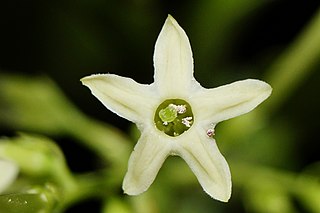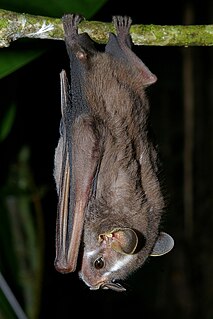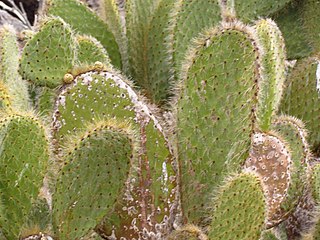
The International Union for Conservation of Nature (IUCN) Red List of Threatened Species, founded in 1964, is the world's most comprehensive inventory of the global conservation status of biological species. It uses a set of criteria to evaluate the extinction risk of thousands of species and subspecies. These criteria are relevant to all species and all regions of the world. With its strong scientific base, the IUCN Red List is recognized as the most authoritative guide to the status of biological diversity. A series of Regional Red Lists are produced by countries or organizations, which assess the risk of extinction to species within a political management unit.

Alternanthera is a genus of flowering plants in the family Amaranthaceae. It is a widespread genus with most species occurring in the tropical Americas, and others in Asia, Africa, and Australia. Plants of the genus may be known generally as joyweeds, or Joseph's coat. Several species are notorious noxious weeds.

Alternanthera philoxeroides, commonly referred to as alligator weed, is a native species to the temperate regions of South America, which includes Argentina, Brazil, Paraguay and Uruguay. Argentina alone hosts around 27 species that fall within the range of the genus Alternanthera. Its geographic range once used to cover only the Parana River region of South America, but it has since expanded to cover over 30 countries, such as the United States, New Zealand, China and many more. This invasive species is believed to have been accidentally introduced to these non-native regions through sediments trapped/attached to tanks and cargo of ships travelling from South America to these various areas.

Wildlife conservation refers to the practice of protecting wild species and their habitats in order to maintain healthy wildlife species or populations and to restore, protect or enhance natural ecosystems. Major threats to wildlife include habitat destruction/degradation/fragmentation, overexploitation, poaching, pollution and climate change. The IUCN estimates that 27,000 species of the ones assessed are at risk for extinction. Expanding to all existing species, a 2019 UN report on biodiversity put this estimate even higher at a million species. It's also being acknowledged that an increasing number of ecosystems on Earth containing endangered species are disappearing. To address these issues, there have been both national and international governmental efforts to preserve Earth's wildlife. Prominent conservation agreements include the 1973 Convention on International Trade in Endangered Species of Wild Fauna and Flora (CITES) and the 1992 Convention on Biological Diversity (CBD). There are also numerous nongovernmental organizations (NGO's) dedicated to conservation such as the Nature Conservancy, World Wildlife Fund, and Conservation International.

Asclepias incarnata, the swamp milkweed, rose milkweed, rose milkflower, swamp silkweed, or white Indian hemp, is a herbaceous perennial plant species native to North America. It grows in damp through wet soils and also is cultivated as a garden plant for its flowers, which attract butterflies and other pollinators with nectar. Like most other milkweeds, it has latex containing toxic chemicals, a characteristic that repels insects and other herbivorous animals.

Cestrum nocturnum, the lady of the night, night-blooming jessamine, night-scented jessamine, night-scented cestrum or poisonberry, is a species of plant in the potato family Solanaceae. It is native to the West Indies, but naturalized in South Asia.

Rhabdophis subminiatus, commonly called the red-necked keelback or red-necked keelback snake, is a species of venomous snake in the family Colubridae. The species is endemic to Asia.

Heller's broad-nosed bat is a bat species from South and Central America.

An IUCN Red List Critically Endangered (CR) species is one that has been categorized by the International Union for Conservation of Nature as facing an extremely high risk of extinction in the wild. As of 2021, there are 6,811 species that are considered to be Critically Endangered. This is out of the 120,372 species currently tracked by the IUCN.

Alternanthera sessilis is an aquatic plant known by several common names, including Matikaduri (মাতিকাদুৰী) in Assamese, ponnanganni, ponnaganti aaku, honnagone, mukunuwenna, sessile joyweed and dwarf copperleaf. It is used as a vegetable specially in Sri Lanka and some Asian countries.

Vachellia rigidula, commonly known as blackbrush acacia or chaparro prieto, and also known as Acacia rigidula, is a species of shrub or small tree in the legume family, Fabaceae. Its native range stretches from Texas in the United States south to central Mexico. This perennial is not listed as being threatened. It reaches a height of 5–15 feet (1.5–4.6 m). Blackbrush Acacia grows on limestone hillsides and canyons.
Alternanthera areschougii is a species of plant in the family Amaranthaceae. It is endemic to Ecuador. Its natural habitats are subtropical or tropical dry forests and subtropical or tropical dry shrubland. It is threatened by habitat loss.

Alternanthera filifolia is a species of flowering plant in the family Amaranthaceae. It is native to the Galápagos Islands.
Alternanthera flavicoma is a species of plant in the family Amaranthaceae. It is endemic to Ecuador.
Alternanthera galapagensis is a species of plant in the family Amaranthaceae. It is endemic to Ecuador.
Alternanthera snodgrassii is a species of plant in the family Amaranthaceae. It is endemic to Ecuador.

Opuntia helleri is a species of plant in the family Cactaceae. This vulnerable species is endemic to the Galapagos Islands (Ecuador), where restricted to Wolf, Darwin, Marchena, and Genovesa.

A vulnerable species is a species which has been categorized by the International Union for Conservation of Nature as likely to become endangered unless the circumstances that are threatening its survival and reproduction improve.

Liatris helleri is a species of flowering plants in the aster family known by the common names Heller's blazing star and Heller's gayfeather. It is native to the Appalachian Mountains of the southeastern United States, found in the states of North Carolina, Virginia, West Virginia, and Maryland. It is threatened by recreational activities in its habitat, and is federally listed as a threatened species.

Alternanthera brasiliana, also known as large purple alternanthera, metal weed, bloodleaf, parrot leaf, ruby leaf, Brazilian joyweed, purple alternanthera, purple joyweed, is a flowering plant of the amaranth family that is native to the forests of South America and as well as Central America. Grown as an ornamental plant, it is very similar in appearance to Alternanthera dentata, which is listed as one of this species's synonyms.

















